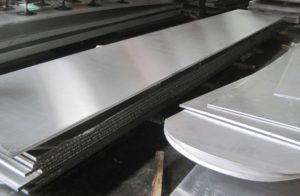Aluminum alloy 7075 is an aluminum alloy, with zinc as the primary alloying element.aluminum 7075 (Al-Zn-Mg-Cu) belongs to super-hard aluminum. As a kind of cold finished wrought alloy, it has great strength and hardness. It’s far better than mild steel. This alloy has good mechanical properties and anode reaction. It is strong, with a strength comparable to many steels, and has good fatigue strength and average machinability.

It has lower resistance to corrosion than many other Al alloys, but has significantly better corrosion resistance than the 2000 alloys. Its relatively high cost limits its use to applications where cheaper alloys are not suitable.aluminum 7075 as a typical kind of aerospace aluminum alloy material is usually used for high-end fields. 7075 aluminum alloy’s composition roughly includes 5.6–6.1% zinc, 2.1–2.5% magnesium, 1.2–1.6% copper, and less than a half percent of silicon, iron, manganese, titanium, chromium, and other metals. It is produced in many tempers, some of which are 7075-0, 7075-T6, 7075-T651.
aluminum 7050 Mechanical properties
7075-0
Un-heat-treated 7075 (7075-0 temper) has maximum tensile strength no more than 280 MPa (40,000 psi), and maximum yield strength no more than 140 MPa (21,000 psi). The material has an elongation (stretch before ultimate failure) of 9–10%. It is very highly corrosion-resistant and has good strength.
7075-T6
T6 temper 7075 has an ultimate tensile strength of 510–540 MPa (74,000–78,000 psi) and yield strength of at least 430–480 MPa (63,000–69,000 psi). It has a failure elongation of 5–11%.
The T6 temper is usually achieved by homogenizing the cast 7075 at 450 °C for several hours, quenching, and then aging at 120 °C for 24 hours. This yields the peak strength of the 7075 alloy. The strength is derived mainly from finely dispersed eta and eta’ precipitates both within grains and along grain boundaries.
7075-T651
T651 temper 7075 has an ultimate tensile strength of 570 MPa (83,000 psi) and yield strength of 500 MPa (73,000 psi). It has a failure elongation of 3–9%. These properties can change depending on the form of material used. Thicker plate may exhibit lower strengths and elongation than the numbers listed above.
7075-T7
T7 temper has an ultimate tensile strength of 505 MPa (73,200 psi) and a yield strength of 435 MPa (63,100 psi). It has a failure elongation of 13%.[5] T7 temper is achieved by overaging (meaning aging past the peak hardness) the material. This is often accomplished by aging at 100–120 °C for several hours and then at 160–180 °C for 24 hours or more. The T7 temper produces a micro-structure of mostly eta precipitates. In contrast to the T6 temper, these eta particles are much larger and prefer growth along the grain boundaries. This reduces the susceptibility to stress corrosion cracking. T7 temper is equivalent to T73 temper.
7075-RRA
The retrogression and reage (RRA) temper is a multistage heat treatment temper. Starting with a sheet in the T6 temper, it involves overaging past peak hardness (T6 temper) to near the T7 temper. A subsequent reaging at 120 °C for 24 hours returns the hardness and strength to or very nearly to T6 temper levels.
RRA treatments can be accomplished with many different procedures. The general guidelines are retrogressing between 180–240 °C for 15 min 10 s.

Comments are closed.